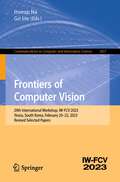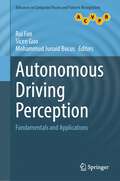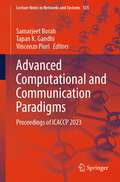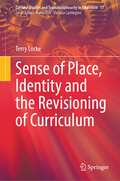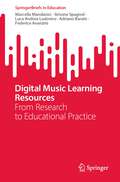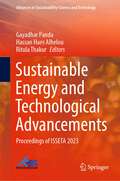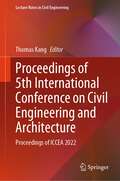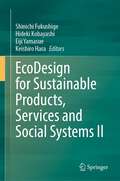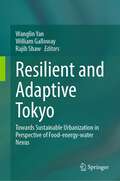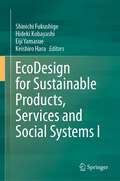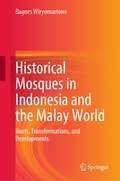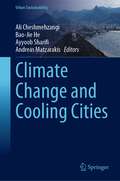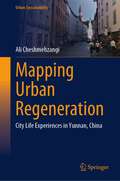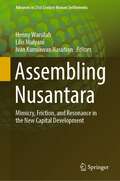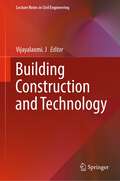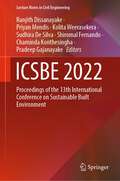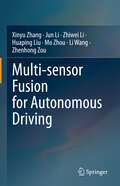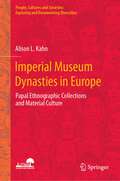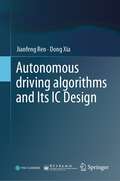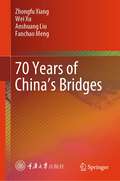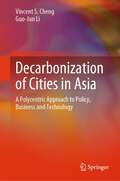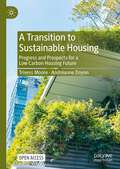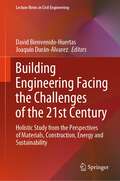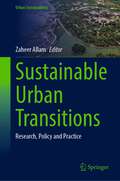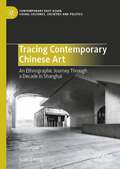- Table View
- List View
Frontiers of Computer Vision: 29th International Workshop, IW-FCV 2023, Yeosu, South Korea, February 20–22, 2023, Revised Selected Papers (Communications in Computer and Information Science #1857)
by Inseop Na Go IrieThis book constitutes refereed proceedings of the 29th International Workshop on Frontiers of Computer Vision, IW-FCV 2023, held in Yeosu, South Korea in February 20–22, 2023. This workshop is an annual event that brings together researchers in the field of computer vision and artificial intelligence to share their research results. The workshop was started 29 years ago as a way to strengthen networking and share research results between Japanese and Korean researchers, and it has since grown in scope and influence, so from 2017, the workshop became an international event. The 13 full papers presented in this volume were thoroughly reviewed and selected from 72 submissions in 8 countries. The papers are dealing with the following topics:basic theories related to image processing, computer vision, image media, and human interface, as well as all research fields in applied fields such as autonomous vehicle driving, robot automation, and image content recognition. Recently, topics related to application of medical, bio, and entertainment field applying artificial intelligence , and more.
Autonomous Driving Perception: Fundamentals and Applications (Advances in Computer Vision and Pattern Recognition)
by Rui Fan Sicen Guo Mohammud Junaid BocusDiscover the captivating world of computer vision and deep learning for autonomous driving with our comprehensive and in-depth guide. Immerse yourself in an in-depth exploration of cutting-edge topics, carefully crafted to engage tertiary students and ignite the curiosity of researchers and professionals in the field. From fundamental principles to practical applications, this comprehensive guide offers a gentle introduction, expert evaluations of state-of-the-art methods, and inspiring research directions. With a broad range of topics covered, it is also an invaluable resource for university programs offering computer vision and deep learning courses. This book provides clear and simplified algorithm descriptions, making it easy for beginners to understand the complex concepts. We also include carefully selected problems and examples to help reinforce your learning. Don't miss out on this essential guide to computer vision and deep learning for autonomous driving.
Advanced Computational and Communication Paradigms: Proceedings of ICACCP 2023 (Lecture Notes in Networks and Systems #535)
by Samarjeet Borah Tapan K. Gandhi Vincenzo PiuriThis book presents high-quality, peer-reviewed papers from Fourth International Conference on Advanced Computational and Communication Paradigms (ICACCP 2023), organized by Department of Computer Science and Engineering (CSE), Sikkim Manipal Institute of Technology (SMIT), Sikkim, India, during February 16–18, 2023. ICACCP 2023 covers advanced computational paradigms and communications technique which provides failsafe and robust solutions to the emerging problems faced by mankind. Technologists, scientists, industry professionals, and research scholars from regional, national, and international levels are invited to present their original unpublished work in this conference.
Sense of Place, Identity and the Revisioning of Curriculum (Cultural Studies and Transdisciplinarity in Education #17)
by Terry LockeThis book explores intersections between sense of place, the formation of identity, indigeneity and colonisation, literature and literary study, the arts, and a revisioned school curriculum for the Anthropocene. Underpinning the book is a conviction that sense of place is central to the fostering of the change of heart required to secure the survival of human life on earth. It offers a coherent overview of seemingly disparate realities on a geographically and historically sprawling canvas. The book is a work of literary non-fiction, drawing on a range of sources: literary works and criticism, theoretical research, empirical studies and artworks. Of its very nature, the book enacts an extensive cultural critique. After establishing a cross-disciplinary foundation for “sense of place”, the book describes its relationship to identity with reference to such terms as attachment, dispossession, reclamation and representation. It shows how a hopeful narrative for planet stewardship can be developed by the uptake of indigenous and traditional discourses of place. It concludes with the envisioning of a place-conscious curriculum, and ways in which an activist agenda might be pursued in the Anthropocene.
Digital Music Learning Resources: From Research to Educational Practice (SpringerBriefs in Education)
by Marcella Mandanici Simone Spagnol Luca Andrea Ludovico Adriano Baratè Federico AvanziniThis book offers an overview of the complex world of digital materials for music education and of their possible use in the everyday practice of music teachers. It presents a multidimensional taxonomy of digital materials for music education. Through the taxonomy it is possible to derive a clear framework of the whole field and to perform analysis of the state of art. The book shows the use of this flexible and powerful knowledge tool for reviewing the digital materials in the various domains and dimentions. The book provides researchers and designers with an overview of what has already been designed, proposed and tested in the field. It also offers music teachers a wider perspective of the possibilities connected to current technologies in the field of music education, and it suggests possible interrelationships between research and music education practices.
Sustainable Energy and Technological Advancements: Proceedings of ISSETA 2023 (Advances in Sustainability Science and Technology)
by Gayadhar Panda Hassan Haes Alhelou Ritula ThakurThis book contains selected papers presented at Second International Symposium on Sustainable Energy and Technological Advancements (ISSETA 2023), organized by the Department of Electrical Engineering, NIT Meghalaya, Shillong, India, during February 24–25, 2023. The topics covered in the book are the cutting-edge research involved in sustainable energy technologies, smart building technology, integration and application of multiple energy sources; advanced power converter topologies and their modulation techniques; and information and communication technologies for smart micro-grids.
Proceedings of 5th International Conference on Civil Engineering and Architecture: Proceedings of ICCEA 2022 (Lecture Notes in Civil Engineering #369)
by Thomas KangThis book states that the proceedings gathers selected papers from 2022 5th International Conference on Civil Engineering and Architecture (ICCEA 2022), which was held in Hanoi, Vietnam on December 16-18, 2022. The conference is the premier forum for the presentation of new advances and research results in the fields of theoretical, experimental, and practical civil engineering and architecture. And this proceedings from the conference mainly discusses architectural design and project management, environmental protection and spatial planning, design and analysis of building materials, and structural engineering and safety. And these materials can be useful and valuable sources for researchers and professionals working in the field of civil engineering and architecture.
EcoDesign for Sustainable Products, Services and Social Systems II
by Shinichi Fukushige Hideki Kobayashi Eiji Yamasue Keishiro HaraThis 2-volume book highlights cutting-edge ecodesign research and covers broad areas ranging from individual product and service design to social system design. It includes business and policy design, circular production, life cycle design and management, digitalization for sustainable manufacturing, user behavior and health, ecodesign of social infrastructure, sustainability education, sustainability indicators, and energy system design. Featuring selected papers presented at EcoDesign 2021: 12th International Symposium on Environmentally Conscious Design and Inverse Manufacturing, it also includes diverse, interdisciplinary approaches to foster ecodesign research and activities. In the context of Sustainable Development Goals (SDGs), in particular SDG 12 (Responsible Consumption and Production), it addresses design innovations for sustainable value creation, considering technological developments, legislation, and consumer lifestyles. Further, the book discusses the conceptof circular economy, which aims to develop circular business models for resource efficient society by taking advantage of digital technologies including artificial intelligence, internet of things, digital twin, data analysis and simulation. Written by experts from academia and industry, Volume 2 focuses on the sustainability assessment of product lifecycle, waste management, material circularity and energy efficiency, food and agriculture, user behavior and health, and transportation. The methods, tools, and practices described are useful for readers to facilitate value creation for sustainability.
Resilient and Adaptive Tokyo: Towards Sustainable Urbanization in Perspective of Food-energy-water Nexus
by Wanglin Yan William Galloway Rajib ShawOur cities, and the systems that support them, have not been designed to address the FWE nexus. There exist gaps in awareness of the role and impacts of climate change. Improving communication among stakeholders with the support of scientific evidence is the key to narrowing the gaps. This book approached this issue with a multidisciplinary and transdisciplinary moveable nexus approach through the lens of FEW nexus under the project of the Sustainable Urbanization Global Initiative of Belmont Forum. It presents a collection of evidence/science-based planning decisions and participatory practices by using Tokyo as the focal area. It visualizes the stock and flow of the Food-Water-Energy (FEW) supporting the world’s largest metropolitan area, explores how the actors have worked together to secure the resilience and sustainability of resources, and demonstrates the potential of resources in making the city adaptive to climatic and social changes. It is designed for researchers in urbanization, nexus research, urban design research, environment, disaster risk reduction, and climate change studies, and can be used as a textbook for university courses. It is also a useful tool for practitioners and policymakers in applying collective knowledge to policy and decision-making.
EcoDesign for Sustainable Products, Services and Social Systems I
by Shinichi Fukushige Hideki Kobayashi Eiji Yamasue Keishiro HaraThis 2-volume book highlights cutting-edge ecodesign research and covers broad areas ranging from individual product and service design to social system design. It includes business and policy design, circular production, life cycle design and management, digitalization for sustainable manufacturing, user behavior and health, ecodesign of social infrastructure, sustainability education, sustainability indicators, and energy system design. Featuring selected papers presented at EcoDesign 2021: 12th International Symposium on Environmentally Conscious Design and Inverse Manufacturing, it also includes diverse, interdisciplinary approaches to foster ecodesign research and activities. In the context of Sustainable Development Goals (SDGs), in particular SDG 12 (Responsible Consumption and Production), it addresses design innovations for sustainable value creation, considering technological developments, legislation, and consumer lifestyles. Further, the book discusses the concept of circular economy, which aims to develop circular business models for resource efficient society by taking advantage of digital technologies including artificial intelligence, internet of things, digital twin, data analysis and simulation. Written by experts from academia and industry, Volume 1 highlights sustainable design such as product and process design, collaborative design, sustainable innovation, digital technologies, design methodology for sustainability, and energy system design. The methods, tools, and practices described are useful for readers to facilitate value creation for sustainability.
Historical Mosques in Indonesia and the Malay World: Roots, Transformations, and Developments
by Bagoes WiryomartonoThe book is an interdisciplinary study on the relationship between Muslims and their mosques in Indonesia and Malaysia. It presents selected historic mosques that demonstrate local interpretations and sociocultural assimilation, as well as a geographical syncretism, of Islam in local societies. The book unveils the contestations, synchronizations, assimilations, and integrations of local and foreign elements into the contextual architecture and sociologically institutionalized system that is the mosque: the Islamic place of worship. The author excavates the mosque’s historical origins and traces the iconic elements, features, and designs from their earliest historical settings and contexts. He then identifies, analyzes, and theorizes the outcomes of the interaction between Islam and local traditions through Malaysian and Indonesian case studies. The book proposes that Islam, at its philosophical level, can be culturally acceptable anywhere because it contains universal virtues of humanity for equality, fraternity, and social justice. The book unfolds how a dialectical contestation and acculturation of Dutch colonialism, Middle Eastern elements of culture, and local customs and traditions, might then come into dialogue, peacefully. Finally, the book considers the relationship between Malay and Indonesian architecture within their respective political cultures, shedding light on Islam and its practice within rich multicultural contexts. Relevant to students and researchers in Islamic studies, architecture, and Southeast Asian studies more broadly, the book uncovers the issues, constraints, and opportunities relating to the meaning of mosques for Muslims in Malaysia and Indonesia.
Climate Change and Cooling Cities (Urban Sustainability)
by Ali Cheshmehzangi Bao-Jie He Ayyoob Sharifi Andreas MatzarakisThis edited book provides a solid foundation for future research on cooling cities, climate change impacts on cities and urban environments, and innovative mitigation and adaptation strategies. With ever-increasing climate change impacts on our living environments and continuous calamities and natural disasters around the world, we urge for new approaches, apt action, and adequate support to boost cooling strategies for the built environments. To achieve this goal, research, practice, and policy could do much more to provide us with new pathways to achieve sustainable development. This book is a comprehensive collection of theoretical perspectives and global case study examples focused on three core areas of (1) concepts, theories, and trends, (2) mitigation and adaptation strategies, and (3) policies. The book is of use to various stakeholders and more importantly to urban specialists, planners and designers, policymakers, academics, practitioners, and developers. We urge them to mitigate climate change before it gets too late. We are confident the book could provide readers with new ideas, strategies, and directions that could lighten up the path toward new actions, policies, and innovation.
Mapping Urban Regeneration: City Life Experiences in Yunnan, China (Urban Sustainability)
by Ali CheshmehzangiThis book is an unusual attempt to study urban regeneration. First, it is based on mapping the realities of urban regeneration case study examples and their impacts on people, places, and city life experiences. Second, it is context-specific, exploring only a particular region rather than covering one country or multiple locations. Hence, the aim is to avoid generic and global solutions but rather focus on local pathways and directions. Third, it delves into specific case study examples that could share some lessons for research, practice, and academia, particularly in the field of urban regeneration. This book is the first of (hopefully) many more on the way in urban mapping studies with various themes and focus areas. The ultimate goal is to ensure urban mapping is recognized well and practiced extensively in research and education. It is essential to map realities in cities and communities, those that we usually witness but should be experienced, perceived, and touched—not just via desk research. Mapping techniques are more than just common tools in urbanism, urban geography, urban studies, urban planning, etc. They are not just tools but inventive ways of understanding cities, places, communities, experiences, and people. Thus, in this book, we try to understand more about people and places through life experiences and mapping the urban regeneration projects of multiple cities in Yunnan Province. This collection is based on a very concise context-specific research focused on only one region. The decision to do so is intentional, just because contextual, cultural, and local attributes need to be looked at more accurately, considerably, and dexterously. Hence, this collection delves into case study examples of an inspiring location where traditions remain, resources are plenteous, and cultures are diverse. Yunnan is one of the few provinces left in China that offers a lot for comprehensive research studies at the urban, rural, and township levels. The experiences we gained from mapping studies, observations, and multi-stakeholder engagements are exceptionally rich and vibrant, allowing us to think more holistically and find ways and suggestions beyond just the generic globalized models elsewhere. We hope the book will be useful to various stakeholders, particularly urban specialists, researchers, and students. It is also a valuable collection for policymakers, decision-makers, and governmental authorities, who should refrain from top-down processes and bring back people to the heart of urban regeneration processes.
Assembling Nusantara: Mimicry, Friction, and Resonance in the New Capital Development (Advances in 21st Century Human Settlements)
by Lilis Mulyani Henny Warsilah Ivan Kurniawan NasutionToday, the new Indonesian capital city, Nusantara, planning is being anticipated as “representing national identity,” “a model city,” or “a gift to the world,” and many other extraordinary labels. This book examines the reality of an ongoing developmental transformation of the Nusantara beyond those labels. It approaches its assemblage of humans, their works (plans, documents, policies, and others), non-human objects (biodiversity, landscape, geography, physical infrastructure, buildings, and public spaces), processes, social relationships, social infrastructures, and others. It is organized into three themes—mimicry, friction, and resonance. The mimicry illustrates the similarities (and differences) between Nusantara and other capital cities in urban narratives, imageries, and forms. The friction studies how Nusantara moves actors who do not always agree, processes that do not always align or collaboration between diverse contradicting groups that intersect. The resonance observes how Nusantara resonates with, yet communicates its voice toward, the world. The three concepts (originated from geography, anthropology, and sociology) frame the analytics of the various contributions of local and foreign scientists from multiple disciplines. Overall, the book recommends “Otorita Ibu Kota Nusantara” (Nusantara capital city authority) on the current experimentation and implementation of the urban vision and provides a reference for social scientists to study Nusantara. And more broadly, the book offers the current socio-spatial practices of capital city-making in Asia that are valuable for the region.
Building Construction and Technology (Lecture Notes in Civil Engineering #360)
by Vijayalaxmi J.This book highlights various aspects of building construction industry based on data from field studies. It discusses the challenges, methodologies, technological applications in building construction, technology, and management. The book presents new approaches to effective building construction and an understanding of the impact of applications of latest technologies. This book is aimed at researchers and professionals in civil engineering and building engineering management to assist in understanding the domain along with recent applications, the advantages, and practical limitations through real-life case studies. This book is useful for building engineers in understanding the effective use of technology, construction methods, and project delivery systems.
ICSBE 2022: Proceedings of the 13th International Conference on Sustainable Built Environment (Lecture Notes in Civil Engineering #362)
by Ranjith Dissanayake Priyan Mendis Kolita Weerasekera Sudhira De Silva Shiromal Fernando Chaminda Konthesingha Pradeep GajanayakeThis book highlights the latest knowledge and innovations in the fields of civil engineering and construction industry striving for a sustainable built environment. It consists of high quality and innovative research findings selected from the proceedings of the 13th ICSBE 2022 under the themes of sustainable construction, urban green infrastructure and planning, rainwater harvesting and water conservation, high-performance concrete, indoor environmental quality and indoor plants, wind and hydro-power energy, waste and wastewater management for enhanced sustainability, impacts of climate change, carbon footprint, global climate model and landscaping, material flows and industrial ecology, sustainable materials, etc.
Multi-sensor Fusion for Autonomous Driving
by Xinyu Zhang Jun Li Zhiwei Li Huaping Liu Mo Zhou Li Wang Zhenhong ZouAlthough sensor fusion is an essential prerequisite for autonomous driving, it entails a number of challenges and potential risks. For example, the commonly used deep fusion networks are lacking in interpretability and robustness. To address these fundamental issues, this book introduces the mechanism of deep fusion models from the perspective of uncertainty and models the initial risks in order to create a robust fusion architecture. This book reviews the multi-sensor data fusion methods applied in autonomous driving, and the main body is divided into three parts: Basic, Method, and Advance. Starting from the mechanism of data fusion, it comprehensively reviews the development of automatic perception technology and data fusion technology, and gives a comprehensive overview of various perception tasks based on multimodal data fusion. The book then proposes a series of innovative algorithms for various autonomous driving perception tasks, to effectively improve the accuracy and robustness of autonomous driving-related tasks, and provide ideas for solving the challenges in multi-sensor fusion methods. Furthermore, to transition from technical research to intelligent connected collaboration applications, it proposes a series of exploratory contents such as practical fusion datasets, vehicle-road collaboration, and fusion mechanisms. In contrast to the existing literature on data fusion and autonomous driving, this book focuses more on the deep fusion method for perception-related tasks, emphasizes the theoretical explanation of the fusion method, and fully considers the relevant scenarios in engineering practice. Helping readers acquire an in-depth understanding of fusion methods and theories in autonomous driving, it can be used as a textbook for graduate students and scholars in related fields or as a reference guide for engineers who wish to apply deep fusion methods.
Imperial Museum Dynasties in Europe: Papal Ethnographic Collections and Material Culture (People, Cultures and Societies: Exploring and Documenting Diversities)
by Alison L. KahnThis book reveals the history of the Vatican’s ethnographic collections by exploring the imperial, scientific, technological, and religious agendas behind its collecting and curating practices in the early twentieth century. It focuses on two principal contributors: the academic, priest, and ‘Pope’s Curator’, Father Wilhelm Schmidt, SVD, and the missionary and linguist, Father Franz Kirschbaum, SVD. Their narratives are embedded in a unique set of comparisons between the ‘liberal humanist ideals’ that underpinned the 1851 Great Exhibition, mid-nineteenth-century German museology, and the 1925 Pontifical Missionary Exhibition. It relates to the period of high colonialism and rampant missionary activity worldwide. It unravels the complicated political and ideological stance taken by the Catholic Church and its place within the science/religion debates of its time. Establishing an essential link between the secular and catholic practices of collecting and curating ethnographic objects from non-Western traditions, the author proposes a broader framework for post-colonial approaches to scholarly studies of ethnographic collections, including those of the Catholic Church. This book appeals to students and scholars of anthropology, museum studies, history, art history, religion, politics, and cultural studies.
Autonomous driving algorithms and Its IC Design
by Jianfeng Ren Dong XiaWith the rapid development of artificial intelligence and the emergence of various new sensors, autonomous driving has grown in popularity in recent years. The implementation of autonomous driving requires new sources of sensory data, such as cameras, radars, and lidars, and the algorithm processing requires a high degree of parallel computing. In this regard, traditional CPUs have insufficient computing power, while DSPs are good at image processing but lack sufficient performance for deep learning. Although GPUs are good at training, they are too “power-hungry,” which can affect vehicle performance. Therefore, this book looks to the future, arguing that custom ASICs are bound to become mainstream. With the goal of ICs design for autonomous driving, this book discusses the theory and engineering practice of designing future-oriented autonomous driving SoC chips.The content is divided into thirteen chapters, the first chapter mainly introduces readers to the current challenges and research directions in autonomous driving. Chapters 2–6 focus on algorithm design for perception and planning control. Chapters 7–10 address the optimization of deep learning models and the design of deep learning chips, while Chapters 11-12 cover automatic driving software architecture design. Chapter 13 discusses the 5G application on autonomous drving. This book is suitable for all undergraduates, graduate students, and engineering technicians who are interested in autonomous driving.
70 Years of China’s Bridges
by Zhongfu Xiang Wei Xu Anshuang Liu Fanchao MengThe book takes time as the axis, selecting 98 bridges (or bridge groups) across the country and 7 representative bridges out of the country, reflecting the steps and development of China's bridge construction in related majors and engineering technicians in colleges and universities. This book aims to let the general public understand the arduous history of China's bridge construction and the rapid development of China's bridge construction without the country's economic development, strength, and hard work of the bridge people. It is also hoped that the public will enjoy the convenience of bridges, highways, railroads, and urban roads and at the same time enhance their awareness of bridge knowledge, knowledge, love, and scientific use of bridges. This book is used by the general public to understand the development of China's bridge construction, but also as a reference book for teachers and students of bridge engineering-related majors and engineering technicians in colleges and universities.
Decarbonization of Cities in Asia: A Polycentric Approach to Policy, Business and Technology
by Vincent S. Cheng Guo-Jun LiThis book provides best practices for decarbonizing cities in East Asia, in which buildings are the major contributor to carbon emissions. Beyond the global commitment through the Paris Agreement to make collective efforts on climate action and accelerated policies, investment and development at the country and city level to combat climate change are occurring at an unprecedented rate. Rapid urbanization and increasing energy demand for large and dense Asian cities require smart and sustainable strategies to balance development with decarbonization. A poly-centric approach is needed, where a combination of policy-, market- and technology-driven changes can aid the transition towards development of carbon neutral cities. With practical examples in the implementation of the United Nations Sustainable Development Goals, green financing, climate action roadmap and policy, deployment of renewable energy, and low- to zero-carbon buildings, readers can find the motivation, considerations and implementation pathways to facilitate the transition into the new normal. It is the hope of the authors to encourage readers to see successful pathways in transitioning into a carbon-free industry and overcoming the effects of climate extremes.
A Transition to Sustainable Housing: Progress and Prospects for a Low Carbon Housing Future
by Trivess Moore Andréanne DoyonThis open access book explores the environmental, social, and financial challenges of housing provision, and the urgent need for a sustainable housing transition. The authors explore how market failures have impacted the scaling up of sustainable housing and the various policy attempts to address this. Going beyond an environmental focus, the book explores a range of housing-related challenges including social justice and equity issues. Sustainability transitions theory is presented as a framework to help facilitate a sustainable housing transition and a range of contemporary case studies are explored on issues including high performing housing, small housing, shared housing, neighbourhood-scale housing, circular housing, and innovative financing for housing. It is an important new resource that challenges policy makers, planners, housing construction industry stakeholders, and researchers to rethink what housing is, how we design and construct it, and how we can better integrate impacts on households to wider policy development.
Building Engineering Facing the Challenges of the 21st Century: Holistic Study from the Perspectives of Materials, Construction, Energy and Sustainability (Lecture Notes in Civil Engineering #345)
by David Bienvenido-Huertas Joaquín Durán-ÁlvarezBuilding engineering is a complex and constantly evolving branch. The needs of the XXI century society cause a constant change in construction industry due to the need to achieve sustainable and ecological buildings. This affects all levels and phases of this engineering. Given this circumstance, numerous researchers turn their efforts to find optimal solutions for building engineering. For this reason, in this book a holistic analysis of building engineering is carried out from the perspectives that have a greater weight for sustainability objectives. The book is divided into 6 sections: (i) Building materials, which deals with research related to the most innovative and sustainable building materials; (ii) Design and construction, which deals with existing methodologies and advances in design and construction in construction sector; (iii) Building repair and maintenance, which deals with building repair, maintenance and upkeep techniques; (iv) Energy efficiency, which analyses the latest research on the energy efficiency of buildings and their behaviour in the face of climate change; (v) Sustainability, which analyses the establishment of measures to achieve a more sustainable built environment; and (vi) construction management, which compiles the latest studies in the field of Project manager. The 38 chapters of the book together constitute an advance for the topic of building engineering. The aspects covered in the book are of great interest to various sectors, such as researchers, engineers, architects, legislators and interested parties.
Sustainable Urban Transitions: Research, Policy and Practice (Urban Sustainability)
by Zaheer AllamThis book aims to explore how sustainability transitions can be explored in current and future cities and how research and policy approaches can be applied to change urban life as we know it, hence aligning the two thematic of urban science and future science, for achieving deep decarbonization. On this, the discourse on philosophy, ethics, and morality appertaining to sustainable cities and urban transitions, across disciplines, are also welcomed as it provides a deeper understanding of humanity in future scenarios. Chapter 08 is available open access under a Creative Commons Attribution 4.0 International License via link.springer.com.
Tracing Contemporary Chinese Art: An Ethnographic Journey Through a Decade in Shanghai (Contemporary East Asian Visual Cultures, Societies and Politics)
by Isaac LeungThis book explores the author's ten-year ethnographic journey in different locations in Shanghai. His immersion in China’s art world is grounded in a topology of places and new ways of writing and deploying history today. The ethnographic approaches to experiencing, analysing and representing space offer a critical tool to explore a different version of realism invisible in the nominal art and art history paradigms. As the market and institutional norms are still being defined, this book also documents and analyses how individuals have strived to negotiate boundaries in the art world and thus create unique selfhood. Instead of conventional methods of periodisation and stylistic analysis, this book presents a historiographic strategy emphasising the philosophical significance of spatial realism to offer insights into history, subjectivities and political institutions.
